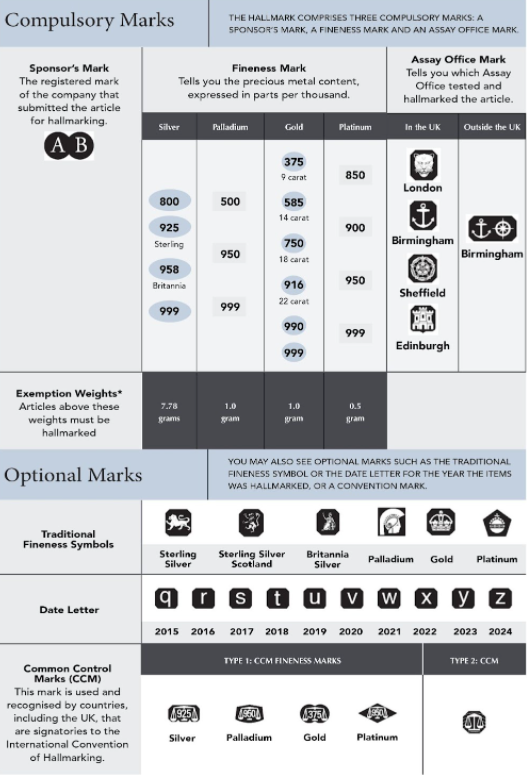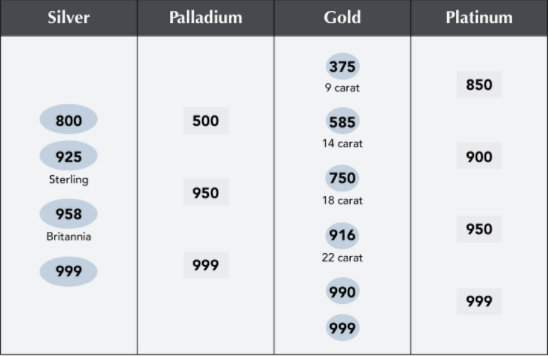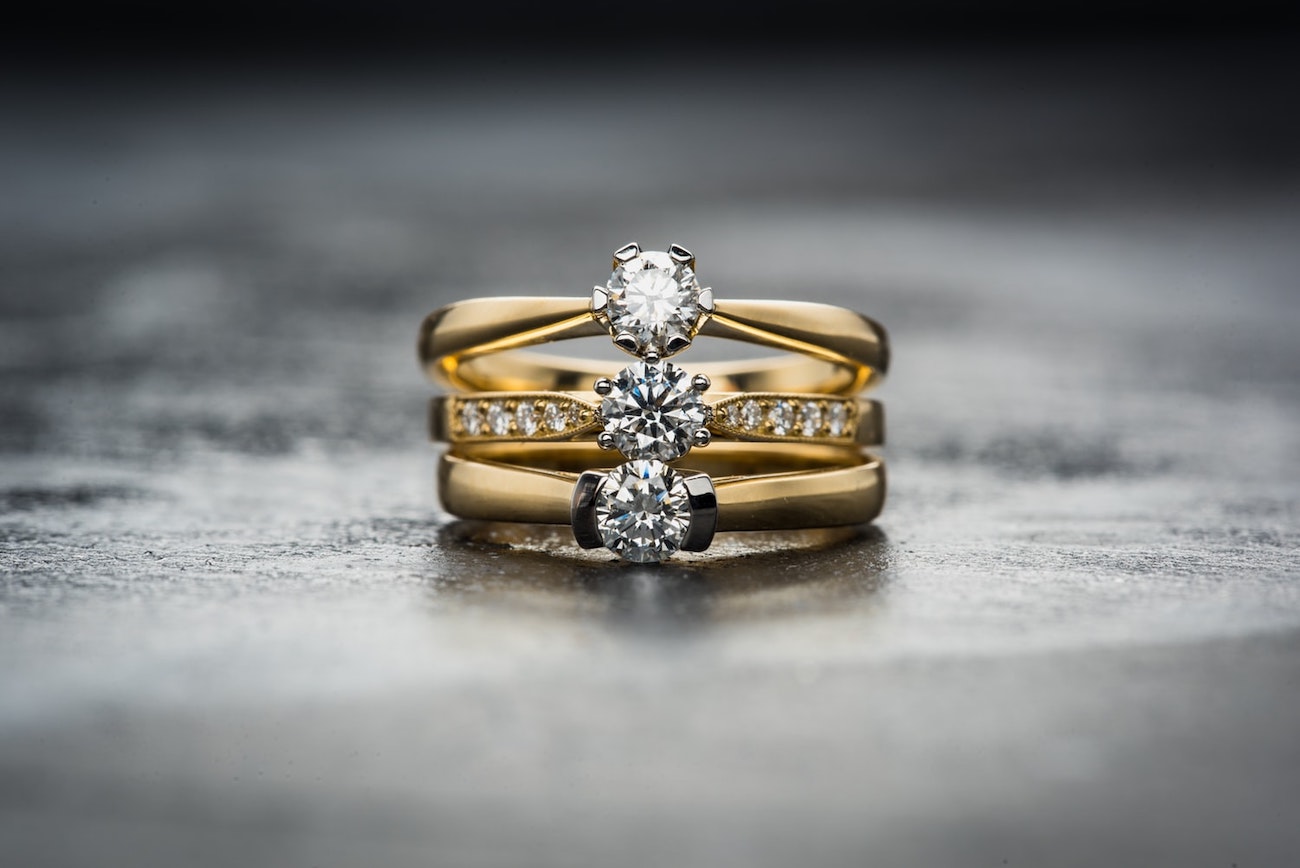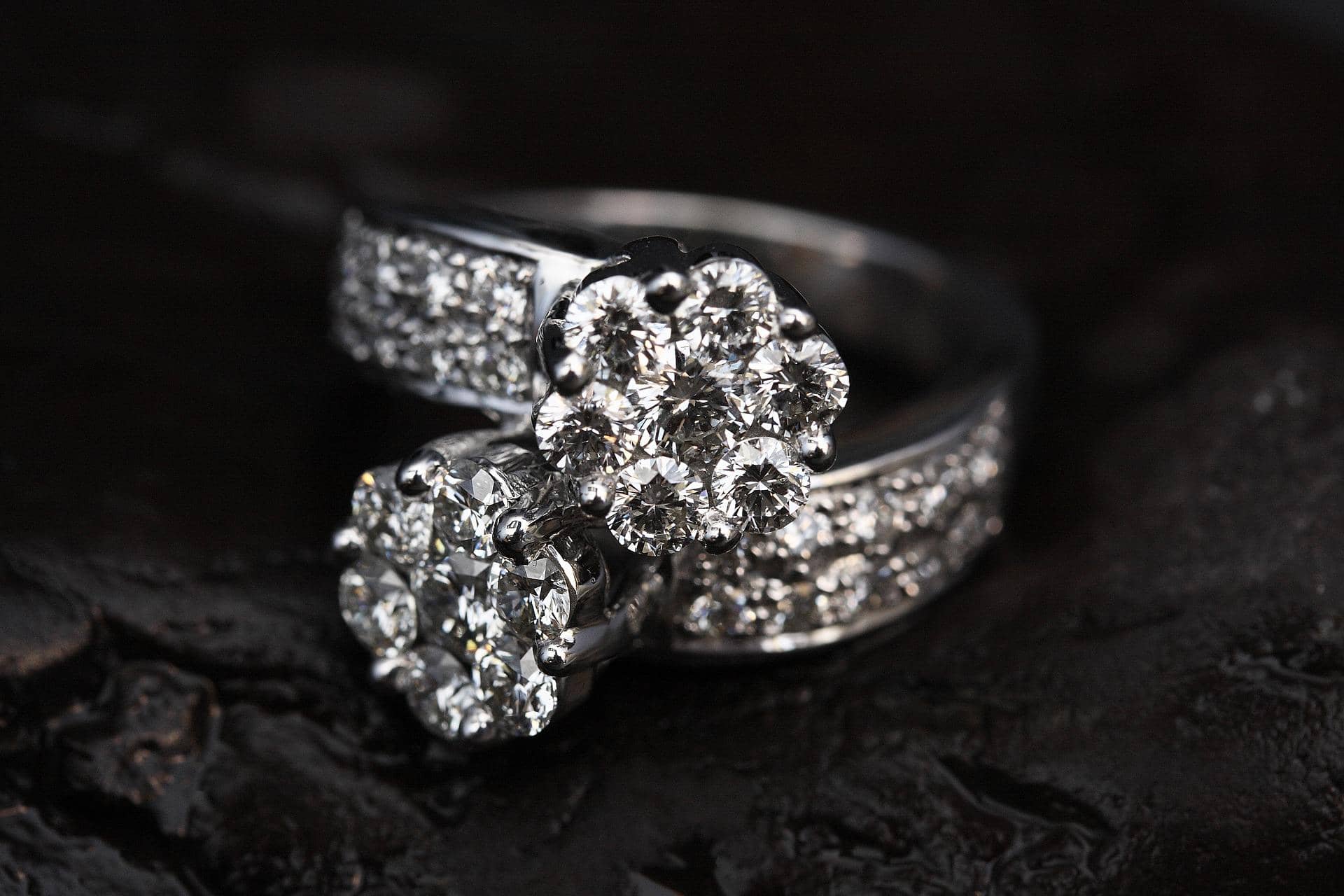When it comes to jewellery hallmarks, distinguishing an individual mark and finding out what it means can be confusing. Whether you’re buying a dazzling gold chain or a sparkling engagement ring and want to know its purity and value, or you’re looking to discover more about the history of a family heirloom, jewellery hallmarks can tell you the story behind your precious metals. Jewellery hallmarks have been part of UK law since 1973, meaning certain precious metals; silver, gold, platinum and palladium (since 2009), have to be stamped with individual marks each referring to a different metal. Yet, for the purpose of workability, wearability and durability, the precious metals stated are rarely used in their purest forms. There are five traditional hallmarks; the assay office, the traditional fineness, the millesimal fineness, the sponsor and the date letter.
WHAT IS A HALLMARK?
A hallmark is stamped on pieces of gold, silver, platinum or palladium by the British assay offices to certify their standard of purity. Precious metals used within jewellery are almost always a mix of pure metal and another metal to give the piece durability and flexibility. UK regulations state that the four main metals, gold, silver, platinum and palladium, all must contain a minimum amount of pure metal for them to be classified as a precious metal – this percentage is commonly known as ‘fineness.’ When purchasing jewellery it’s important to know that what you are buying is genuine as it’s almost impossible to tell certain metals apart just from sight or touch. This means there is a possibility of fraud, so hallmarking is seen as protection for jewellery buyers and suppliers as it ensures that the jewellery items are crafted from genuine precious metals.
WHAT DOES A HALLMARK SHOW?
Within the four assay offices around the UK, every piece of jewellery is independently tested and marked to assure that it is crafted from precious metals of certain purity. Hallmarking is similar to diamond certification but instead the hallmark details the maker’s name, where it was assayed, the purity of the metal, when it was made and if it commemorates a special national event. Hallmarks are usually set on a horizontal line and are in the order of; sponsor, fineness (purity) and assay office. Placed somewhere inconspicuous on the jewellery such as the inside of a ring band or the back of a pendant, a jewellery hallmark creates little disruption to the aesthetics.
WHAT METALS ARE HALLMARKED?
Four precious metals – gold, silver, platinum and palladium – all require testing and hallmarking to be legally sold as genuine. The minimum weight that requires hallmarking for each metal is as follows:
- 0.5 grams for platinum
- 1 gram for gold
- 1 gram for palladium
- 7.78 grams for silver

WHAT ARE THE COMPULSORY HALLMARKS?
WHAT ARE THE ASSAY OFFICE HALLMARKS?
The UK houses four assay offices, and each is privately run and overseen by the British Hallmarking Council. An assay office is where jewellery is tested, the metal is verified, and stamped appropriately. The assay offices are located across the UK in Birmingham, Edinburgh, London and Sheffield, and each location has a unique signature.
- The Birmingham Assay Office hallmark signature is an anchor
- The Edinburgh Assay Office Hallmark signature is a castle
- The London Assay Office Hallmark signature is a leopard head
- The Sheffield Assay Office Hallmark signature is a rose
MILLESIMAL FINENESS MARK SIGNATURES
The traditional fineness mark and millesimal fineness mark reveals which precious metal the item is crafted from. However, the traditional mark is now optional. Ultimately, the fineness of a precious metal refers to the weight of fine metal when taken in proportion to the total weight of a piece of jewellery.
- Silver – oval shape
- Sterling silver uses 92.5% pure silver in its composition, so consequently, its hallmark number is 925. Britannia Silver uses 95.8% silver, making for a marking of 958.
- Gold – rectangular shape
- Yellow, white and rose gold are commonly referred to in carat weights and a marking is made in relation to the purity. 9 carat gold translates to a marking of 375, 14 carat gold constitutes 585, and 18 carat gold of 750.
- Platinum – five sided shape
- Platinum products use 95% pure platinum in its composition, therefore it’s hallmarked 950.
- Palladium – trapezium or three circles
- With 50- 95% purity of metal, the hallmark for palladium is either 500 or 950.

SPONSOR’S MARK
The individual who sends your jewellery items to the nearest assay office for testing, evaluation and hallmarking, must mark the metal in order for it to be identified. This mark could refer to the manufacturer, the importer, the wholesaler or the retailer. Usually, the signature mark comes in the form of initials within a shape.
WHAT ARE THE OPTIONAL HALLMARKS?
DATE LETTER MARK
Each year, on the 1st January, a new date stamp is created and the last year’s stamp is destroyed. In 1999 date stamps became optional, so modern jewellery items today won’t have a date letter mark. Each year when the stamp changes so does the font and shape, making it easy for you to tell when the article was assayed. These are a great way of identifying the age of the jewellery piece.
TRADITIONAL FINENESS MARK
You may also find a traditional fineness mark, in addition to the compulsory fineness mark. These marks are applied as standard at the London assay office but are optional elsewhere.
COMMEMORATIVE MARK
Commemorative marks are stamps applied to articles to commemorate landmark national events. Commemorative marks are optional but are a useful indication of age as they are related to a date in time.
CONVENTION MARK
The UK has been a signatory to the Interventional Convention of Hallmarks since 1972. This is an international convention to provide a safeguard for the trade of jewellery across borders by hallmarking internationally recognised ‘control marks’.



